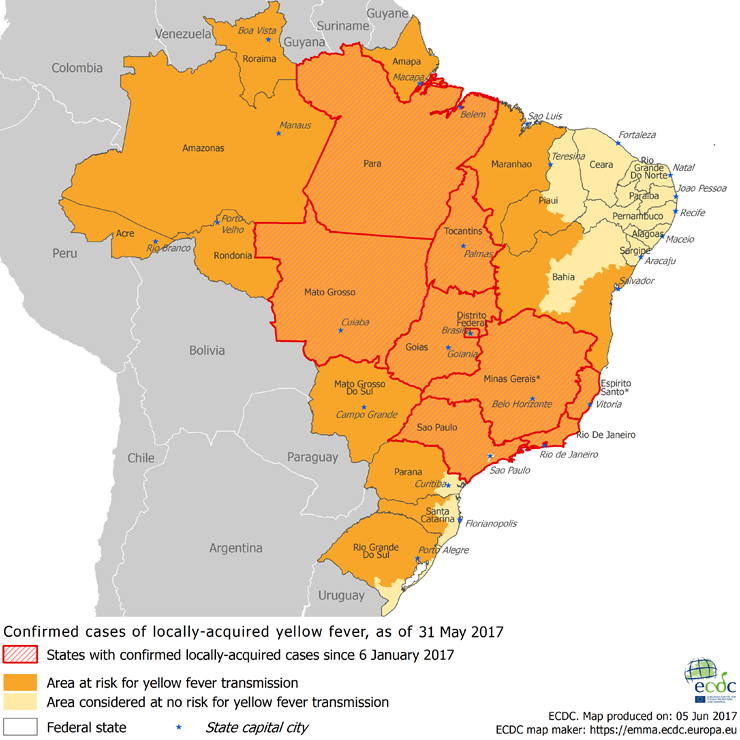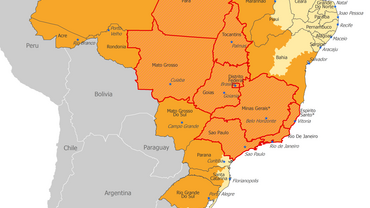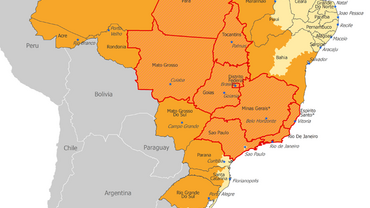Epidemiological update: Yellow fever outbreak in Brazil, 23 March 2017
Between 6 January and 16 March 2017, Brazil has reported 1 357 cases (933 suspected and 424 confirmed), including 249 deaths (112 suspected and 137 confirmed). The case-fatality rate is 18.3% among all cases and 32.3% among confirmed cases.

Yellow fever is a mosquito-borne viral infection present in some tropical areas of Africa and South America.In South America, there are two transmission cycles of yellow fever:- A sylvatic cycle, involving transmission of the virus between Haemagogus or Sabethes mosquitoes and primates. The virus is transmitted by mosquitoes from primates to humans when humans are visiting or working in the forest.- An urban cycle, involving transmission of the virus between Aedes aegypti mosquitoes and humans. The virus is usually introduced in an urban area by a viraemic human who was infected in the forest.Brazil has been experiencing an outbreak of yellow fever since December 2016. The outbreak was notified on 6 January 2017.
After the WHO DON posted on 20 March, WHO recommend vaccination of international travellers above nine months going State of Rio de Janeiro, with the exception of the urban areas of Rio de Janeiro City and Niterói, and the State of São Paulo, with the exception of the urban areas of São Paulo City and Campinas.
Weekly Summary
Since 16 March 2017, national public health authorities in Brazil have not reported any new confirmed case of yellow fever. WHO has extended its vaccination recommendations to the state of Rio de Janeiro, with the exception of the urban areas of Rio de Janeiro City and Niterói, and to the State of São Paulo, with the exception of the urban areas of São Paulo City and Campinas.This week, according to WHO PAHO update, Peru reported one additional case.
Epidemiological Summary
Between 6 January and 16 March 2017, Brazil has reported 1 357 cases (933 suspected and 424 confirmed), including 249 deaths (112 suspected and 137 confirmed). The case-fatality rate is 18.3% among all cases and 32.3% among confirmed cases.States reporting suspected and confirmed autochthonous cases:- Minas Gerais has reported 1 074 cases (749 suspected and 325 confirmed), including 189 deaths (78 suspected and 111 confirmed).- Espírito Santo has reported 243 cases (150 suspected and 93 confirmed), including 48 deaths (26 suspected and 22 confirmed).- São Paulo has reported 15 cases (11 suspected and four confirmed), including four deaths (one suspected and three confirmed).- Rio de Janeiro has reported three cases (one suspected and two confirmed), including one confirmed death.States reporting suspected autochthonous cases: - Bahia has reported eight suspected cases, including one fatal.- Tocantins has reported six suspected cases, including one fatal.- Rio Grande do Norte has reported one suspected case, fatal.- Goiás has reported three suspected cases, not fatal.In addition, investigations are ongoing to determine the probable infection site of four further suspected cases.
Other countries in South America:
From week 1 to 11 of 2017, five other countries reported suspected and/or confirmed cases of yellow fever: Bolivia (1), Colombia (1), Ecuador (1), Peru (8) and Suriname (1).This week, WHO PAHO reported one additional case in Peru. From the beginning of the year to 23 March 2017, Peru has notified three confirmed cases and five probable cases. Among these eight cases, two have died.
ECDC Assessment
The ongoing outbreak should be carefully monitored, as the establishment of an urban cycle of yellow fever would have the potential to quickly affect a large number of people. EU/EEA citizens who travel to, or live in, areas where there is evidence of yellow fever virus transmission should check their vaccination status and obtain medical advice about being vaccinated against yellow fever.In Europe, Aedes aegypti, the primary vector of yellow fever in urban settings, is present in Madeira. Recent studies have shown that Aedes albopictus can potentially transmit the yellow fever virus. However, the risk of the virus being introduced into local competent vector populations in the EU through viraemic travellers from Brazil is considered to be very low, as the current weather conditions in Europe are not favourable for vector activity.
ECDC closely monitors this event in collaboration with the World Health Organization. ECDC published a rapid risk assessment on 26 January 2017 and a rapid risk assessment on yellow fever among travellers returning from South America on 15 March 2017. ECDC is also producing a map for travel advice.







